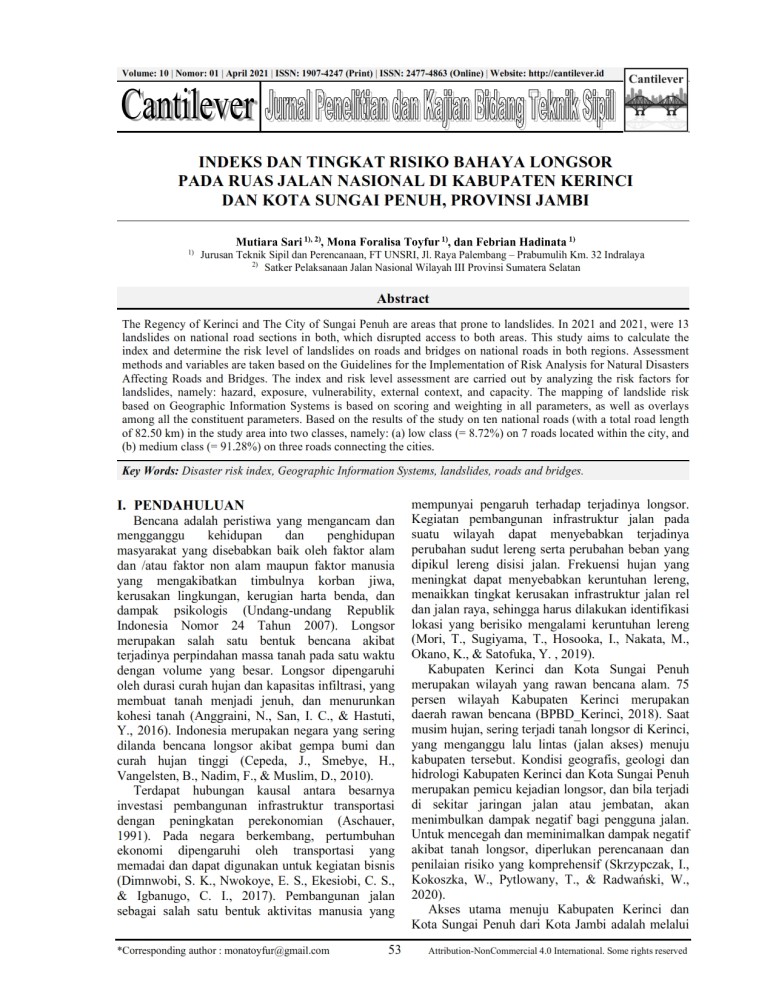Indeks dan Tingkat Risiko Bahaya Longsor pada Ruas Jalan Nasional di Kabupaten Kerinci dan Kota Sungai Penuh, Provinsi Jambi Landslide Hazard Index and Risk Level on National Road Sections in Kerinci Regency and Sungai Penuh City, Jambi Province
Main Article Content
Abstract
The Regency of Kerinci and The City of Sungai Penuh are areas that prone to landslides. In 2021 and 2021, were 13 landslides on national road sections in both, which disrupted access to both areas. This study aims to calculate the index and determine the risk level of landslides on roads and bridges on national roads in both regions. Assessment methods and variables are taken based on the Guidelines for the Implementation of Risk Analysis for Natural Disasters Affecting Roads and Bridges. The index and risk level assessment are carried out by analyzing the risk factors for landslides, namely: hazard, exposure, vulnerability, external context, and capacity. The mapping of landslide risk based on Geographic Information Systems is based on scoring and weighting in all parameters, as well as overlays among all the constituent parameters. Based on the results of the study on ten national roads (with a total road length of 82.50 km) in the study area into two classes, namely: (a) low class (= 8.72%) on 7 roads located within the city, and (b) medium class (= 91.28%) on three roads connecting the cities.
Downloads
Article Details
Aschauer, A. (1991). Transportation Spending and Economic Growth. Washington DC: American Public Transit Association.
Balai_Pelaksanaan_Jalan_Nasional_Jambi. (2021). Rekapitulasi Lokasi Longsor di Provinsi Jambi. Jambi.
BPBD_Kerinci. (2018). 75 Percent of Kerinci Area is Disaster Prone. Retrieved August 26, 2020, from http://metrojambi.com/read/2018/11/19/37419/75-persen-wilayah-kerinci-rawan-bencana.html
Cepeda, J., Smebye, H., Vangelsten, B., Nadim, F., & Muslim, D. (2010). Landslide risk in Indonesia. Jakarta: ISDR.
Davidson, R. (1997). An Urban Earthquake Disaster Risk Index. California: The John A. Blume Earthquake Engineering Centre.
Dimnwobi, S. K., Nwokoye, E. S., Ekesiobi, C. S., & Igbanugo, C. I. (2017). Transportation infrastructure and diversification of Nigeria’s economy: implications for the developmental state. The Nigerian journal of economic and social studies, 59(3), 309-330.
Kementerian_Pekerjaan_Umum. (2014). Pedoman dan Petunjuk Pelaksanaan Analisis Risiko Bencana Alam Yang Berdampak Pada Jalan dan Jembatan. Jakarta.
Kepmen_PUPR_No.248/KPTS/M/2015. (t.thn.). Penetapan Ruas Jalan Dalam Jaringan Jalan Primer Menurut Fungsi Sebagai Jalan Arteri (JAP) dan Jalan Kolektor-1 (JKP-1). Jakarta.
Mori, T., Sugiyama, T., Hosooka, I., Nakata, M., Okano, K., & Satofuka, Y. . (2019). Slope Failure Risk Assessment Modeling Using Topographic Data and Numerical Calculation of Soil Conservation by Tree Root Systems. ISPRS Annals of the Photogrammetry, Remote Sensing and Spatial Information Sciences, Volume IV-2/W5 (pp. 217-222). Netherlands: Enschede.
Skrzypczak, I., Kokoszka, W., Pytlowany, T., & Radwański, W. (2020). Landslides and the risk of damage to road infrastructure on the example of a transport node. Nodes in Transport Networks – Research, Data Analysis and Modelling (pp. 53-62). Katowice, Poland: Springer.
Undang-undang Republik Indonesia Nomor 24 Tahun 2007. (n.d.).

This work is licensed under a Creative Commons Attribution-NonCommercial 4.0 International License.
Authors who publish with this journal agree to the following terms:
- Authors retain copyright and grant the journal right of first publication with the work simultaneously licensed under a Creative Commons Attribution-NonCommercial 4.0 International License that allows others to share the work with an acknowledgment of the work's authorship and initial publication in this journal.
- Authors are able to enter into separate, additional contractual arrangements for the non-exclusive distribution of the journal's published version of the work (e.g., post it to an institutional repository or publish it in a book), with an acknowledgment of its initial publication in this journal.
- Authors are permitted and encouraged to post their work online (e.g., in institutional repositories or on their website) prior to and during the submission process, as it can lead to productive exchanges, as well as earlier and greater citation of published work (See The Effect of Open Access).
